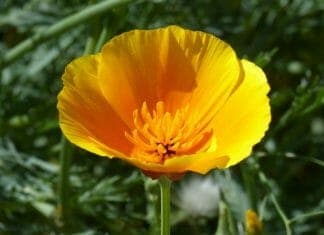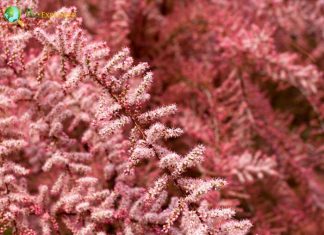
Desert Flowers: Approximately 1/3 of the earth’s surface is composed of deserts. A desert is a region or landscape that receives very little precipitation. For this reason, the plants living in the desert must have adaptations to survive.
Despite having prolonged periods without precipitation, severe temperature ranges, dry winds, and low humidity, the beautiful flowers of the desert have learned to survive the harsh environment and continue to bloom and provide colors to the desert.
![]()
Different Types of Desert Flowers
Apache Plume
Flower Type: ShrubsDeserts: Mojave, Chihuahuan, Great Basin, Sonoran
Aromatic Aster
Flower Type: PerennialsDeserts: Chihuahuan
Artemisia
Flower Type: PerennialsAsian Spider Flower
Flower Type: AnnualsDeserts: Thar
Brittlebush
Flower Type: ShrubsDeserts: Mojave, Sonoran
California Poppy
Flower Type: AnnualsDeserts: Sonoran, Mojave, Antelope Valley
Canaigre Dock
Flower Type: PerennialsDeserts: North American Deserts
Copao
Flower Type: TreesDeserts: Atacama Desert
Desert Horse Purselane
Flower Type: AnnualsDeserts: Thar
Desert Lily Flower
Flower Type: AnnualsDeserts: Areas of the Southwest of North America, Northwestern Mexico, Mojave, and Sonoran.
Desert Rose
Flower Type: ShrubsDeserts: Sahel regions South of Sahara, Tropical Africa, and Arabian Peninsula.
Desert Sand Verbena
Flower Type: AnnualsDeserts: Mojave and Sonoran, deserts of Southwestern US and Northern Mexico.
Desert Snowberry
Flower Type: ShrubsDeserts: Chihuahuan
Elephant Trunks
Flower Type: TreesDeserts: Namib desert
Hoodia Cactus
Deserts: KalahariLemon’s Rubberweed
Flower Type: BiennialsDeserts: Great Basin
Little Larkspur
Flower Type: PerennialsDeserts: Great Basin
Mount Finke Grevillea
Flower Type: ShrubsDeserts: Great Victoria Desert (Australia)
Old-Man’s Beard
Flower Type: PerennialsDeserts: Okanaga, Mojave and Sonoran.
Sedum
Flower Type: ShrubsTamarix Shrubs
Flower Type: Shrubs/TreesDeserts: Junggar Basin Region of the Gobi and Sahara.
Turpentine Broom
Flower Type: ShrubsDeserts: Deserts of the southwestern United States and northern Mexico, Mojave, and Sonoran.
White Saxaul
Flower Type: Shrubs/TreesDeserts: Rub' al-Khali
White Wormwood
Flower Type: ShrubsDeserts: Syrian desert and Sinai desert.
What is a Sahara desert flower?
Deserts, such as the Sahara, the largest hot desert in the world, may give the impression of being lifeless, but they are home to a range of unique plant species that have adapted to survive in harsh desert conditions. These plants have developed remarkable strategies to thrive in these arid environments, where water is scarce and extreme temperature fluctuations.
One example is Panicum Turgidum, desert grass. This desert flowering plant has exceptional drought resistance, enabling it to endure the water-deprived desert landscape.
Various species of Acacia trees are also found throughout the Sahara. These trees possess deep root systems that allow them to access groundwater, and their small leaves help minimize water loss.
- Date palms are another significant plant species in the Sahara oases. These trees provide valuable sustenance through their nutritious fruits and offer materials for construction and crafting.
- Cleome Africana is a beautiful flowering plant that blooms amidst the Sahara’s sandy dunes. Its striking white blossoms create a stark contrast against the desert backdrop.
- Cistanche Phelypaea is an intriguing parasitic plant in the desert. Lacking chlorophyll, it derives nutrients and water from the roots of other plants. Its vibrant flowers typically range from bright yellow to orange-red.
- Euphorbia candelabrum is a plant reminiscent of a cactus with a thick, fleshy stem that stores water. This adaptation allows it to withstand prolonged periods of drought.
It’s important to acknowledge that the Sahara is not uniformly barren and sandy. It encompasses various terrains, including rocky areas, gravelly stretches, mountain ranges, and even wetlands and grasslands in certain regions.
Each of these diverse environments fosters distinct forms of plant life. Additionally, some of the mentioned plant species may only bloom following infrequent rainfall events, during which they swiftly germinate, flower, and produce seeds before the return of arid conditions.
All organisms thrive to survive. This is also true with plants living in the desert environment. So, the next time we hear the word “desert”, our thoughts must not be limited to the harsh environment, but we must also appreciate the beauty of the desert shrubs, blooms, and other plants that provide life to the desert landscape. These desert flowers have found unique ways to survive the scarcity, heat, and poor soils.










































